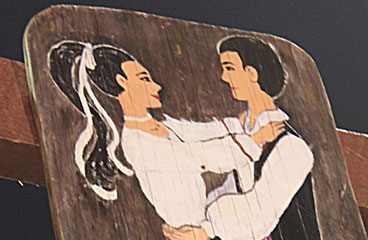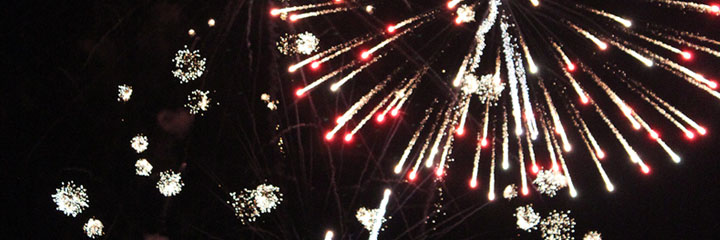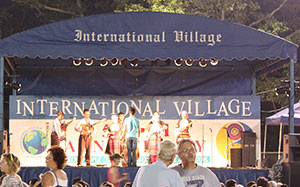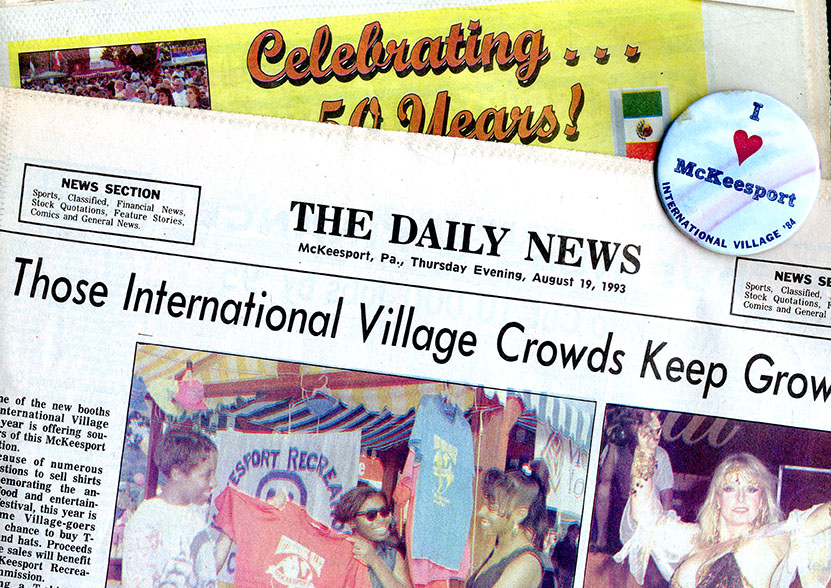
International Village began in July 1960 as part of a 10-day celebration of McKeesport history called “Old Home Week.” Held then on Market Street, Downtown, between Fifth and Sixth avenues, the event was described as “gaily decorated booths from which the respective national groups will dispense native foods and display original handicraft work.”
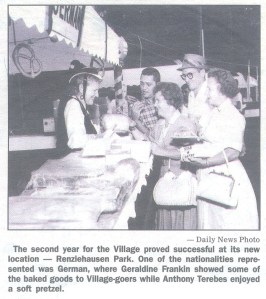
Flags of the different nations were hung above the street. Musical and dance performances, provided by each of the booths, were a part of International Village from the beginning.
Charter participants in the first International Village—held July 6, 7 and 8, 1960—were the Greek, Polish, Ukrainian, Serbian, Hungarian, Italian, Croatian, Romanian, Irish and Jewish booths.
International Village outlived “Old Home Week” and quickly grew in attendance and size, and was moved to Renziehausen Park in 1961. The event’s success gained it national notoriety and led to similar ethnic food and music festivals around the country.
International Village celebrated its 50th year in 2009 and its 60th year in 2019. (Source: “McKeesport: A Bicentennial Commemorative,” 1976; “Old Home Week: McKeesport, Pa.,” 1960)
About the Logo

The International Village logo was created by graphic artist Marie Killian Race, who worked for McKeesport-based G.C. Murphy Co., a national chain of variety stores. The emblem incorporates the McKeesport City Seal and a globe with a Chinese “taijitu” symbol, which represents the concept of “yin and yang,” or the way that different views are actually interconnected and interdependent.
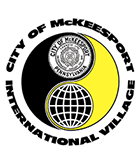
After being used “unofficially” for many years, McKeesport City Council in 2008 voted to make Race’s emblem the official symbol of International Village. That year, Race received a mayoral proclamation on the stage of International Village.
About McKeesport
Located at the confluence of the Monongahela and Youghiogheny Rivers and part of the Pittsburgh metropolitan area, McKeesport is the second-largest city in Allegheny County. It is located on the Monongahela River, one of the busiest inland ports in the United States, as well as the network of hiking-biking trails that connects Pittsburgh with Washington, D.C.
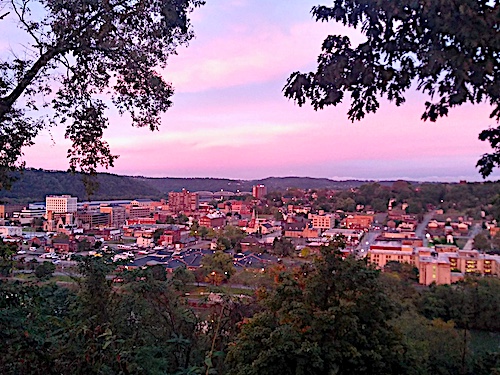
In the 1750s, George Washington often came to the present-day McKeesport area to visit his friend, Queen Alliquippa, a Seneca Indian ruler. About 1795, John McKee, an original settler of Philadelphia and son of David McKee, built a log cabin near the confluence of the Monongahela and Youghiogheny rivers. After taking over his father’s local river ferry business, he devised a plan for a city to be called McKee’s Port.
After being settled by the McKee family, McKeesport began to grow, especially after coal mines opened in around 1830. The first schoolhouse was built in 1832, and the city’s first steel mill was established in 1851. For decades, McKeesport’s National Tube Works manufactured iron and steel pipes and once employed as many as 10,000 men. The city had more than 55,000 residents by 1940. (Source: Wikipedia)
About ‘Renzie’ Park
A $50,000 donation from local department store owner Henry H. Renziehausen helped fund the creation of the park that bears his family’s name. The first 16 acres of what is now Renziehausen Park (or “Renzie,” as it’s affectionately known) were purchased in 1931 from the McKeesport Turn and Gesang Verein (“Turners”) club. The city borrowed an additional $140,000 to purchase surrounding acreage.
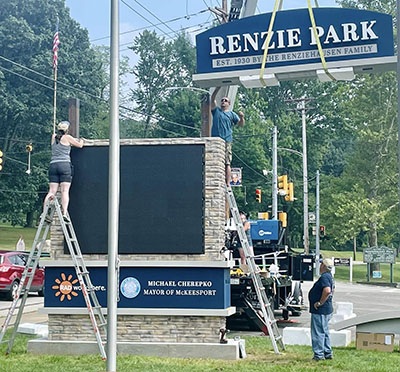
Emilie Renziehausen left funds for the establishment of “Lake Emilie,” a man-made pond which is stocked with fish. Nearby ballfields are named for prominent former McKeesporters, including Stephen Barry, who dedicated his life to helping the poor through the St. Vincent de Paul Society.
Renzie now encompasses 258 acres, including the Lions Bandshell, a fitness trail, an enclosed pavilion/exhibit center, the McKeesport Heritage Center museum and archives, picnic facilities, and Pennsylvania’s second-largest certified rose arboretum. Maintained by volunteers, McKeesport’s Rose Garden and Arboretum contains some 1,200 rose bushes in 28 beds, plus 300 miniature rose bushes.
In addition to International Village, “Renzie” hosts such events as McKeesport’s Summer Concert Series, a vendor market and baseball and softball tournaments.

Once primarily an asset for McKeesport and its suburbs, Renziehausen Park now draws visitors from throughout the Pittsburgh region and upkeep and improvements to the facility are funded in part by the Allegheny Regional Asset District (RAD).



